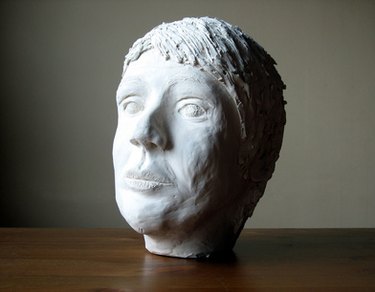
Plaster of Paris parts set very quickly but may take several days to completely cure. There are some things you can do to speed up the process--or even slow it down, if you wish. Though plaster of Paris parts of various sizes require different lengths of time to cure, the technique is the same.
Variables
Video of the Day
Several factors determine the length of time it takes for plaster of Paris parts to cure. Humidity, room temperature, water additives or mineral content, the amount of water used and even the method of mixing and the condition of the plaster directly affect the amount of curing time necessary. As a general rule, plaster parts set to cure at room temperature take from 20 to 30 minutes to harden, though denser, thicker pieces may require longer times. Pieces mixed in extremely cold temperatures will also take longer to set.
Video of the Day
Water Temperature
The temperature of the water used to mix plaster of Paris plays a vital role in the length of time it takes for a plaster part to set. Plaster of Paris mixed with cold water takes a significantly longer time to cure than plaster mixed with warm water. The higher the temperature of the water used, the more rapidly the drying of plaster of Paris parts occurs.
Speeding the Process
To speed the curing of plaster of Paris parts, salt can be incorporated into the mixture. Plaster of Paris mixed with hot, salty water cures much more rapidly than plaster mixed with cooler, unsalted water.
Slowing the Process
A material called glue size added to the plaster of Paris mixture interferes with the drying time, slowing the process and allowing a slight amount of additional time to form the plaster parts. Using cold water to mix the plaster of Paris also makes the pieces set more slowly.
Self-Generated Heat
During the curing phase, plaster of Paris parts become warm, sometimes even hot, to the touch. This self-generated heat signifies that the drying process is occurring. Once the plaster of Paris parts have begun to cool, the pieces have set. The complete curing of a part may take several days, depending upon the size and density of the item.
Air Circulation
To complete the curing process, place the plaster of Paris parts in a warm, dry location. Set the pieces on a clean, elevated oven rack to allow plenty of air flow. A clean cake rack works well for smaller pieces. Leave the plaster of Paris parts undisturbed until they feel cool and dry to the touch. Completely cured pieces can be sanded and finished as desired.
- Eastern Kentucky University: General Sculpture Information on Plaster
- ArtLex Art Dictionary: Plaster or Plaster of Paris
- ArtLex Art Dictionary: Glue Size
- Springfield Telescope Makers, Inc.: How to Make a Plaster Disk
- University of North Carolina Department of Physics and Astronomy: Four-Point Bending Lab Group Project
- Princeton University: Section 14--Sculpture